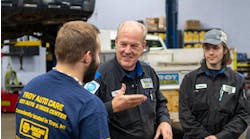The constant reports of new vehicle technology and trends and the threat they pose to shops are nearly impossible to avoid. Whether it’s changes in necessary tools, equipment or training, vehicle technology is changing more rapidly than ever.
Chris Chesney, senior director of professional markets for CARQUEST, asserts that although the coming changes will impact the way shops work, those changes won’t occur overnight. Chesney recently sat down with Ratchet+Wrench to discuss the upcoming changes in new vehicle technologies, what shops can do now to prepare, and the timeframe they have to prepare.
What are some of the new vehicle technologies and trends that will impact the way shops work?
The technology that will actually impact shops is completely different than what is in the news. When you look at the news, you see things like electric vehicles, autonomous vehicles, telematics, and alternative fuel vehicles. In reality, the vehicles that shops will be faced with over the next 10 years are not that different than the vehicles they see today or what they need to be prepared to work on today, such as gas directed injections (GDI), expanding data networks, increasingly complex transmission technologies, and using fluids that are specified for the vehicle by engineers.
All that technology is here today. What shops need to understand is that the OEMs don’t believe the technology that’s out there today is the end-all to reducing our dependence on foreign oil and improving the environment.
What do you see as the solution then?
The end game is fuel cell technology. How can the manufacturer get from where they are today to where they need to be by 2025? By that timeframe, the OEMs want a fuel cell technology that has an infrastructure where you can go buy hydrogen across the street to support that technology. That infrastructure doesn’t even exist today.
A lot of people in the industry don’t recognize that current technologies are more transition than anything. The sexy nature of telematics and a car that drives itself are really cool but that’s been going on for years. Those technologies will be here someday, but we’re talking 20 years down the road before it’s fully accepted.
A lot of work needs to be done before we get there, and that’s unfortunate because it scares the shop owner. It gives them an uneasy feeling about how they’re going to survive in this industry when the facts are that the cars they’re working on today are going to be coming in their shop for many years.
What are the gaps you see in getting ready for these changes?
I think the biggest gaps are in training. Because our industry doesn’t have performance standards, there’s not a requirement for continuing education. There is a desperate need for technicians to improve their foundational skills in electronics, computer logic, and networking skills. Shops need to find one or two resources that gives them the ability to grow with their knowledge base. Technicians also need to have the desire at the tech level to apply that, learn more and get better.
What kind of tools and equipment are needed?
Shops need an OE-level scan tool. There are a handful of aftermarket scan tools that do an excellent job on probably 85–90 percent of vehicles that a shop will hook up to. Shop owners need to understand the vehicles that they work on and their market and then choose both scan tools and service information to match that market. If their primary customer base is 50 percent Toyota and they don’t own a Toyota factory scan tool and service information system, then why are they even in business? There are so many shops that don’t. It’s only going to get worse.
The problem is that it’s the fundamentals that every shop and technician need to focus on. It’s basic electrical, having quality multi-meters and the skills to be able to apply them appropriately. Lab scopes are not a fundamental tool but they’re becoming one.
How do you see these changes impacting day-to-day business?
Compared to even 10 years ago, customers don’t show up as often. Service intervals have been extended both due to marketing and technology. The OEMs want the car to last about 150,000 miles and then sell the customer a new one. So the car doesn’t break in the first 100,000 miles like it used to. You don’t see the repair work coming into the shop today like it used to.
The challenge is really for the shop owner to recognize that there are failures out there but the gravy isn’t there anymore. There are still brake jobs and wheel service and things of that nature, but not as often. At the end of the day, shops need to recognize that the jobs they send away or think are under warranty are jobs they can actually service. They can get the information needed. It’s a whole different mindset that the industry needs today.
Can you provide a timeline for these technologies?
There are timelines that the California Resource Board uses to predict what the vehicle mix needs to look like over the next 35 years. The end game for California is a greenhouse gas reduction of 80 percent by the year 2050. The only way you get to a reduction of that magnitude is by not burning fossil fuels.
What that requires the manufacturer to do is transition that technology over a period of time. That’s difficult because today’s vehicle lasts so long. It’s going to take time and that is in the aftermarket’s favor because it means those cars are going to be around for a while.
The 2025 time frame of trying to get shops ready for fuel cell vehicles is when they’ll start selling fuel cell vehicles. By that point, our market will look like the market of today with respect to hybrids. Hybrids are still only a small percentage of vehicles on the road. In 2025, fuel cell vehicles will only be a small percentage of vehicles on the road.
There are also a lot of what-ifs here. This transition will only happen if they can build an affordable vehicle and the economy’s strong enough to buy and it’s acceptable. At the end of the day, consumers could be opposed to buying it. Look at what’s happened with the diesel market in this country.
What do shops need to do now to prepare for the changes in technology?
I think the number one thing shops need to do today is set standards of performance in their business. Put together a business plan that creates expectations of your people with respect to the amount of training they take, the type of training, how they approach a job, the systems they use, the training on their equipment. That goes for customer service advisors, too.
Make sure that within the four walls of that business, they have standards of performance set. Their business will grow both financially and in reputation.



